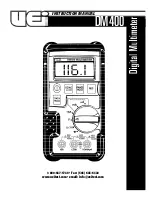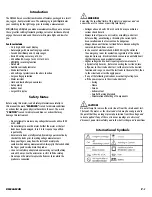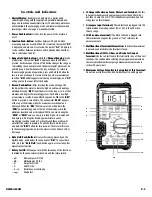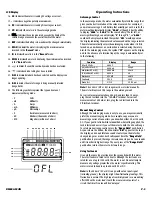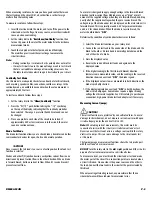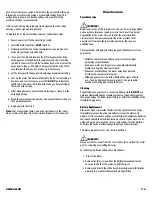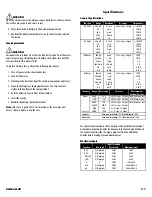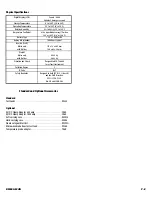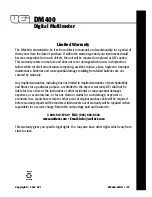
Measuring AC or DC Volts
WARNING!
To avoid the risk of electrical shock and instrument damage, input
voltages must not exceed the limits specified for the installation
category you are working in.
DO NOT
attempt to take any unknown
voltage measurements that may exceed these values.
This meter is designed for measuring voltages in residential, household
appliances and light commercial applications. Industrial applications
often exceed the limitations of this meter. Dangerous power surges are
likely to occur on industrial power lines. If the maximum measurement
value is unknown or is likely to exceed the meter’s rated limit,
DO NOT
attempt to make that measurement with this meter. Consider using
current clamps in high power situations whenever practical.
Note:
When taking voltage measurements your meter must be
connected in parallel to the circuit, or circuit element, under test.
To improve the accuracy of DC voltage measurements taken in the
presence of AC voltages, (such as measuring the DC offset voltage of an
amplifier in the presence of an AC signal), measure the AC voltage first.
Note the AC voltage range and select a DC voltage range that is the
same or higher than the AC voltage range. This method improves the
DC voltage accuracy by preventing the input protection circuits from
being activated.
To measure AC or DC volts:
1. Set the rotary dial to “
V
”. select “
AC
” or “
DC
” by pressing
the “
DC/AC
” push-button. The meter will select the
appropriate range.
2. plug the red lead into the V/
Ω
/mA/µA terminal, and the black lead
into the “
C OM
” input terminal of the meter.
3. Disconnect the power from the circuit to be tested.
4. Connect the test leads to the circuit to be tested.
5. Reapply power to the circuit. The measured voltage will
be displayed.
6. For DC measurements, when the input to the V /
Ω
/mA/µA terminal
is lower (more negative) than the “
C OM
” (or low) input terminal, a
minus polarity sign will appear on the left of the display.
7. Disconnect power to the circuit before removing the test leads
from the circuit.
Measuring Three-Phase AC Volts
WARNING!
DO NOT
exceed the maximum voltage rating of the meter.
When measuring three phase power systems, remember there are
some important steps to ensure safe multimeter use.
When measuring three phase circuits line to line, the voltage in a Wye
system is 1.73 times higher phase to phase than it is phase to ground.
If you connect the meter to a three phase system with a 480 V AC phase
to ground rating, the voltage from phase to phase is over 831 V AC. This
exceeds the maximum rating of this meter and may result in personal
injury or instrument damage.
Measuring Resistance
CAUTION!
Turn off the power, and discharge all the capacitors on the circuit to
be tested before attempting “in circuit” resistance measurements.
Failure to do so may result in unit-under-test or instrument damage.
The resistance measuring circuit applies a small, known value of
constant current through the unknown resistance. It then uses the
voltage developed across the measured circuit to calculate resistance.
It is critical to both the welfare of the meter and the accuracy of the
measurement that you remove all power to the circuit under test when
making resistance measurements. If any voltage is present in the test
circuit, whether from a conventional power supply or energy stored in
a capacitor, an erroneous reading will result. This meter may be
damaged if voltage in excess of 600 volts is present while measuring
ohms or continuity.
Note:
When measuring critically low ohm values, touch test lead tips
together and record the reading. Subtract this value from the total
circuit resistance to obtain the most accurate value.
When measuring large resistance values, the reading may be unstable
due to environmentally induced electrical noise. If this occurs, connect
the resistor directly to the meter input terminals in place of the test
leads. It may also be possible to use an electrical shield on the resistor
connected to the same ground plane as the “
COM
” input terminal to
obtain a stable reading.
For resistance measurements above one megohm the display might take
a few seconds to stabilize. This is normal for high resistance readings.
The meter has a circuit to protect the resistance ranges from voltages
of up to 600 volts AC. However, to prevent accidentally exceeding the
protection circuit rating and to ensure a correct measurement,
NEVER
CONNECT THE TEST LEADS TO A SOURCE OF VOLTAGE
when the
rotary dial is set to ohms, continuity or diode test functions.
The current applied during resistance measurements could damage
some devices. The table below lists the test voltages and currents
induced at each resistance range. (All values are typical)
Note:
(A) The open circuit test voltage at the input terminals,
measured in volts
(B) The voltage drop across a resistance equal to full scale value
( C ) The current thro u gh a short circuit at the input terminals
DM400-MAN
P. 4
Range
400
Ω
4k Ω
40 kΩ
400 kΩ
4 MΩ
Full Scale
Voltage (B)
315 mV
560 mV
435 mV
440 mV
414 mV
Open Circuit
Voltage (A)
2.99 V
0.83 V
0.55 V
0.55 V
0.51 V
Short Circuit
Current (C)
760 µA
409 µA
50.4 µA
5.6 µA
0.7 µA

